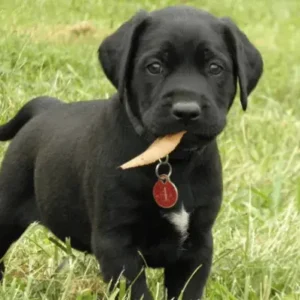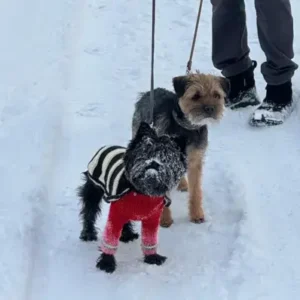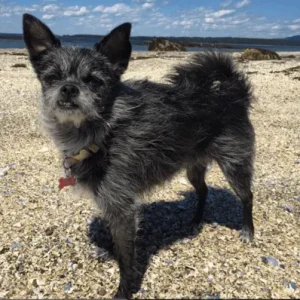American English Coonhound History and Origin
The American English Coonhound, a purebred dog, descends from the English Foxhound, which British settlers brought to the United States around the 17th and 18th centuries.
The English Foxhound was bred with other breeds, including the Virginia hound and Bluetick Coonhound, to create the American English Coonhound. They were previously called English Fox and belongs to the Hound Group.
Virginia hound – Source: Pinterest
Bluetick Coonhound – Source: AKC.org
American English Coonhound – Source: AKC.org
It was first brought to America from England in 1817 by George Washington. The American English Coonhound was recognized as a distinct breed by the United Kennel Club in 1905. Whereas, the American Kennel Club’s Foundation Stock Service recognized it in 1995. By 2011, it was listed as eligible to participate in the National Dog Show.
American English Coonhound in 1920’s- Source: AKC.org
These dogs were bred for hunting foxes but were also used for hunting other small game, including raccoons. The word “coon” is a corruption of the word “raccoon.” Over time, these dogs became known as “coonhounds.” They are also called Redtick coonhounds.
American English Coonhound Personality
American English Coonhounds are active dogs that require plenty of exercise to stay happy and healthy. A daily walk or jog is essential, along with some playtime in the backyard or at the park. They also thrive when participating in agility, tracking, and hunting activities.
Due to their sociable nature, American English Coonhounds should not be left alone for long periods. They may become bored and destructive without proper mental and physical stimulation. Regular social interaction and activities with their family are important to keep them content and fulfilled.
- American English Coonhound Temperament
This breed is known for its friendly and loyal nature towards its family members. They enjoy spending time with their loved ones and are protective of them, making them great watchdogs.
While they are friendly with their family, American English Coonhounds can be reserved around strangers. They may bark at new people or animals that enter their homes or yards. Socializing American English Coonhound puppies is crucial to help them feel more comfortable around unfamiliar individuals and animals.
These dogs are intelligent and quick learners, readily picking up new commands and tricks. However, they can also be stubborn and headstrong at times, requiring patience and consistency during training. Once they understand what is expected of them, they are eager to comply.
Coonhounds are first and fundamentally working dogs bred for hunting. They need lots of exercise, like hunting, jogging, hiking, or swimming.
It’s risky to let them off-leash if they’re not trained for hunting because they’ll follow scents anywhere, even onto roads. An enclosed dog park is safest. Well-exercised coonhounds are calm, while those lacking exercise can be energetic and difficult to handle.
American English Coonhound Physical Appearance
This dog breed has some of the most handsome dogs. One of the most distinguishing features of the American English Coonhound is their large floppy ears set high on their head. The ears are long and droopy and hang down past their jawline.
The head of the American English Coonhound is large and proportional to its body size. They have a long muzzle with a defined stop between their eyes.
Their nose is black with large nostrils that allow them to have an excellent sense of smell. Its expressive eyes are almond-shaped and set far apart. They are dark in color with tight rims around the eyelids.
- American English Coonhound Size
The American English Coonhound is a large dog. They are slightly longer than they are tall, with a deep chest, well-defined muscles, a strong back, and a long tail carried low.
The average American English Coonhound weight lies between 50 to 80 pounds and stands 21 to 27 inches tall at the shoulder.
- American English Coonhound Colors
The American English Coonhound has a short to medium-length, dense coat that is easy to care for. The coat is smooth and can be any color, including black, tan, red, blue, or tricolor.
The most common coat pattern is black with tan markings on the head, chest, and legs. Their coats could also be ticking red and white, blue and white ticked, tricolored with ticking, white and black, and red and white.
Black and Tan Coonhound – Source: AKC.org
American English Coonhound Gender Differences
When choosing between a male and female American Coonhound, there are pros and cons to consider for each sex.
Males, for example, are typically more affectionate and easier to train than females. They also tend to be less independent and more attached to their owners. On the downside, males can be more prone to marking their territory inside the house and may be more likely to roam if not properly trained.
On the other hand, females are often more independent than males and can be less affectionate. They’re also typically cleaner than males and have less of a tendency to mark their territory inside the house.
However, females can be more difficult to potty train than males and may be more prone to escaping from the yard if not properly trained.
- Size
Males are typically larger and stronger than females, weighing in at an average of 65 pounds compared to the female’s 55 pounds.
If you’re looking for a big dog to cuddle with, then the male American Coonhound is the way to go. However, a female might be better if you live in a smaller home or have small children.
American English Coonhound Feed/Nutrition
Depending on the age, weight and activity level of the dog breed, their nutritional needs will vary. This blog post will discuss the top nutrition tips for the American English Coonhound.
- Feed them a high-quality diet – This is probably the most important tip. A high-quality diet will ensure your dog gets all the nutrients to stay healthy. It’s important to do your research when choosing a food for your dog and to consult with your veterinarian if you have any questions. Incorporating healthy treats like banana and apple can also offer extra vitamins and fiber to their diet.
- Avoid table scraps – While it may be tempting to give your dog table scraps, it’s important to avoid doing this as much as possible. Table scraps are often unhealthy for dogs and can cause them to become overweight or obese. Almonds should also be avoided, as dogs cannot digest them properly, and they may pose a choking hazard or cause digestive issues.
- Give them plenty of exercise – Exercise is important for all dogs, but it is especially important for American English Coonhounds. These dogs were bred for hunting and had a lot of energy. Be sure to give them plenty of opportunities to run and play so that they can burn off some of that excess energy.
- Know their nutritional needs – As we mentioned, each breed of dog has different nutritional needs. Be sure to research and know what nutrients your American English Coonhound needs to stay healthy. Consult with your vet if you have any questions or concerns.
- Feed them on a regular schedule – It’s important to feed your American English Coonhound regularly so they can maintain a healthy weight. Free feeding (leaving food out all day) is not recommended as it can lead to obesity.
American English Coonhound Health
Overall, the American English Coonhound is a relatively healthy breed. However, like all dogs, they may be prone to certain health problems such as:
- Hip Dysplasia: It is a condition that affects the hip joint. The hip joint is a ball and socket joint, and in dogs with hip dysplasia, the ball and socket do not fit together properly. Hip dysplasia can cause pain and lameness in the affected dog.Consider hip dysplasia screening for breeding dogs to reduce the risk of passing on the condition to offspring. Provide supplements like glucosamine and chondroitin to support joint health and function.
- Cancer: Cancer is a general term to describe any abnormal growth of cells in the body. Canine cancer can affect any part of the body. American English Coonhounds are prone to several types of cancer, including Osteosarcoma (bone cancer), Lymphoma, and Hemangiosarcoma (cancer of the blood vessels). Early detection is key in treating cancer successfully. Avoid exposure to environmental toxins and carcinogens whenever possible.
- Eye Problems: American English Coonhounds are prone to several eye helath issues, including cataracts, glaucoma, and cherry eye. These conditions can cause blindness if left untreated. Regular eye exams by a veterinarian are recommended to catch these problems early. Be cautious when exposing your dog to eye hazards, such as sharp objects or chemicals, and take appropriate precautions to prevent injuries.
- Ear Infections: Ear infections are also common in American English Coonhounds. They are caused by bacteria or yeast getting into the ear canal and causing an infection. If you think your dog has an ear infection, you should take them to the vet so it can get the proper treatment. Avoid using cotton swabs or inserting foreign objects into your dog’s ears, as this can damage the ear canal and increase the risk of infection.
Regular veterinary check-ups and a proper care regimen can help maintain their well-being.
American English Coonhound Care and Grooming
American English Coonhounds have a short, easy-to-maintain coat that requires regular brushing to remove loose hair and minimize shedding.
Here are some grooming tips for American English Coonhounds:
- Brush their coats regularly. This will help remove any dirt or debris that may be tangled in their fur, as well as help distribute natural oils throughout their coat.
- Bathe them as needed. Depending on your dog’s activity, they may need to be bathed anywhere from once a week to once a month. Be sure to use a dog-specific shampoo so as not to dry out their skin.
- Check their ears regularly. They can easily collect dirt and debris, leading to infection if not cleaned out regularly.
- Trim their nails as needed. If you can hear their nails clicking on the floor when they walk, it’s time for a trim!
- Clean their teeth regularly. This is important for oral and overall health, as bacteria from the mouth can easily enter the bloodstream if not kept in check.
- Give them regular exercise. This will help to keep their coat healthy and free of tangles, as well as help them maintain a healthy weight and nutritious diet. A healthy diet will help to keep their coat shiny and free of excess shedding.
- Groom them in a calm environment. This will help to prevent them from getting too excited and making the grooming process more difficult than it needs to be!
Grooming can be lengthy, especially if you’re dealing with mats or tangles, so it’s important to have patience and take your time so you don’t end up hurting your dog in the process.
Using proper dog training tips can also help make grooming a more pleasant experience, as your dog will learn to stay still and cooperate during the process.
American Coonhound Price
The price of an American English Coonhound typically ranges from $800 to $2,000, depending on the breeder and the dog’s pedigree.
When purchasing an American English Coonhound from a breeder, it’s crucial to do thorough research and ensure that the breeder follows responsible breeding practices.
American English Coonhound Rescue Group
Several rescue organizations specialize in Coonhounds and can provide information about adopting dogs in need of loving homes.
Interesting Facts
- Historical records suggest that George Washington may have been one of the earliest individuals in North America to own an American English Coonhound.
- A remarkable trait of American English Coonhounds is their ability to climb trees, an advantageous skill during hunting expeditions, allowing them to pursue prey that seeks refuge in branches.
- The breed made a significant mark in history by securing victory in the first major Coon Dog Trial, highlighting their prowess in hunting and tracking competitions.
- American English Coonhounds have a place among the top 12 most “talkative” dog breeds.
Best For
American English Coonhounds are high-energy dogs that are best suited for active individuals or families who enjoy outdoor activities such as hiking, running, or hunting. They thrive in environments where they can receive regular exercise and mental stimulation.
American English Coonhound Top Names
| Male American English Coonhound | Female American English Coonhound |
| Ranger | Daisy |
| Hunter | Bella |
| Duke | Sadie |
| Cooper | Molly |
| Tucker | Lily |









 Virginia hound – Source:
Virginia hound – Source:  Bluetick Coonhound – Source:
Bluetick Coonhound – Source:  American English Coonhound – Source:
American English Coonhound – Source:  American English Coonhound in 1920’s- Source:
American English Coonhound in 1920’s- Source: 

 Black and Tan Coonhound – Source:
Black and Tan Coonhound – Source: 







